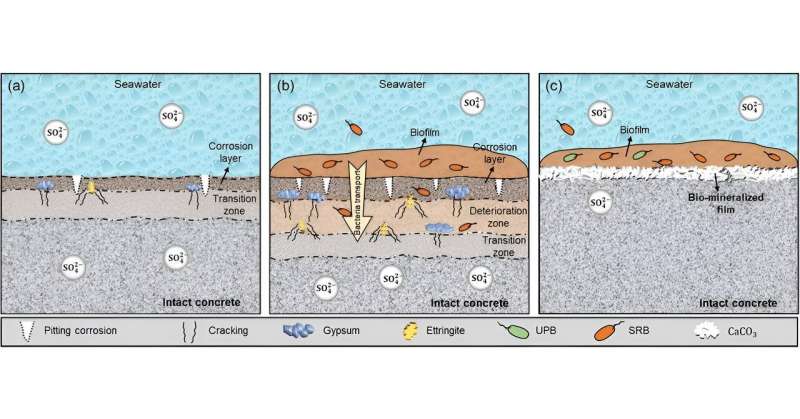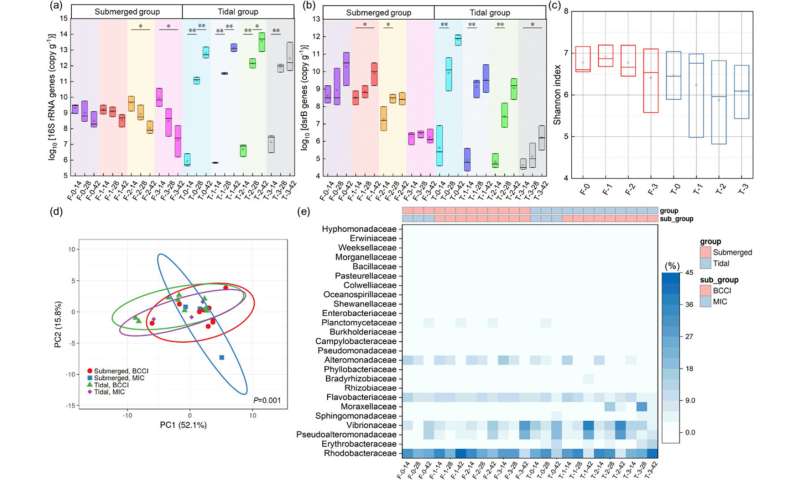Microbially induced corrosion (MIC) is a prevalent issue in marine environments, leading to structural damages such as cracking in concrete infrastructure. This corrosion poses a persistent challenge, significantly reducing the lifespan of marine structures and resulting in substantial economic losses.
In response to the need for an effective solution to combat the marine corrosion on concrete, researchers at the Hong Kong Polytechnic University have developed a biomineralization approach to protect marine concrete from MIC.
Prof. Xiang-dong Li, Dean of the Faculty of Construction and Environment, Director of the Research Institute for Sustainable Urban Development, Chair Professor of Environmental Science and Technology, and Ko Jan Ming, Professor in Sustainable Urban Development, has led the research that successfully introduced a novel biomineralization strategy, which effectively isolates marine concrete from MIC, thereby contributing to the achievement of sustainable coastal structures.
MIC on concrete usually occurs in harsh environments with the presence of corrosive microorganisms, such as sewage structures, wastewater treatment plants, and marine structures. The formation of a biomineralized film on concrete surfaces is typically considered to be the major anticorrosion mechanism, as it can provide a barrier to inhibit corrosion.

Prof. Li said, “The biomineralization technique serves as an environmentally friendly coating method for controlling concrete corrosion, with minimal impact on the overall biofilm communities. Also, it utilizes carbon dioxide to produce mineral precipitates, enhancing the durability of concrete structures.”
“This process not only reduces the carbon footprint and energy consumption of marine infrastructure throughout its lifespan but also makes a valuable contribution to carbon neutrality and sustainability.”
The study showed the biomineralization treatment effectively prevents corrosion by reducing the total and relative abundance of sulfate-reducing bacteria (SRB). SRB is a type of anaerobic bacteria and can produce hydrogen sulfide, which is corrosive and can lead to material deterioration.
The biomineralized film acts as a protective layer, controlling sulfate diffusion and isolating the concrete from the corrosive SRB communities. This protective mechanism significantly extends the lifespan of concrete structures. Moreover, this technique has no negative impact on the native marine microbial communities.
Prof. Li added, “If the biomineralized film remains intact, repainting the concrete structures is unnecessary. The utilization of a single coating treatment eliminates the need for multiple treatments, further minimizing the cost and carbon footprint.”
This biomineralization strategy has strong potential for applications in corrosive environments, such as marine environments, sewage environments, and water cooling utilities, where concrete corrosion is induced by corrosive microorganisms.
The research, titled “Biomineralization to prevent microbially induced corrosion on concrete for sustainable marine infrastructure” was published in Environmental Science & Technology.
The study employed a combination of chemical and mechanical property measurements of concrete, along with an analysis of the microbial community of biofilms, to evaluate the effectiveness of biomineralization techniques in inhibiting the corrosion of marine concrete. These assessments aimed to enhance understanding of MIC development. The results contribute to the development of new techniques for inhabiting corrosion to achieve sustainable marine concrete structures.
In a sulfate chemical attack, calcium hydroxide and calcium aluminate hydrate will be consumed to form gypsum and ettringite, resulting in expansion stress and matrix fracture. In a MIC attack, bacteria can colonize the corroded layer, which provides an excellent medium for microorganisms to grow. Microbial activity can extend beyond the corrosion layer near to the surface and spread across the deterioration zone.
-

qPCR analysis of evolution for concentrations (copy g–1) of (a) 16S rRNA gene and (b) dsrB in concrete biofilms. Panel (c) is the α diversity of biofilm communities at the species level (Shannon index). Panel (d) shows differences in the microbial communities as visualized with PCoA. The permutational multivariate analysis of variance (PERMANOVA) was used to test differences in the microbial communities between the groups. P < 0.05 was regarded as the criterion for statistical significance in any differences. Ovals indicate the 95% confidence intervals for each sample type. Panel (e) shows the proportion of bacteria from concrete biofilms classified at the family level as being in the top 20. Credit: 2024 Research and Innovation Office, The Hong Kong Polytechnic University. All Rights Reserved. -

Changes in (a) SRB profiles and (b) SOB profiles in different concrete biofilms, respectively. Credit: 2024 Research and Innovation Office, The Hong Kong Polytechnic University. All Rights Reserved.
Compared with chemical corrosion, MIC causes more severe damage to marine concrete structures. However, the formation of the biomineralized film on the concrete surfaces led to higher surface pH (potential of hydrogen) and lower surface sulfate concentrations, which also acted as a protective layer to control the diffusion of sulfate and isolate the concrete from SRB communities, decreasing internal sulfate levels.
Considering that the type of colonized surface also affects the treatment effect of biomineralization, the effectiveness of biomineralization will be further investigated for different types of concrete to expand its applicability potential. In addition, the functional prediction can be used in future studies to obtain a mechanistic understanding of the possible metabolic capability of microbial action on concrete corrosion.
This understanding is beneficial for uncovering the mystery between SRB and the lifespan of marine concrete structures.
More information:
Xiaohao Sun et al, Biomineralization To Prevent Microbially Induced Corrosion on Concrete for Sustainable Marine Infrastructure, Environmental Science & Technology (2023). DOI: 10.1021/acs.est.3c04680
Citation:
Researchers introduce biomineralization as a sustainable strategy against microbial corrosion in marine concrete (2024, February 23)
retrieved 25 February 2024
from https://techxplore.com/news/2024-02-biomineralization-sustainable-strategy-microbial-corrosion.html
This document is subject to copyright. Apart from any fair dealing for the purpose of private study or research, no
part may be reproduced without the written permission. The content is provided for information purposes only.

